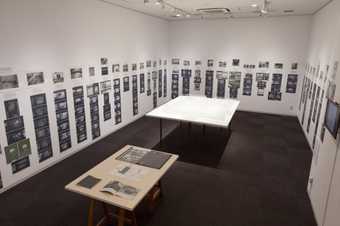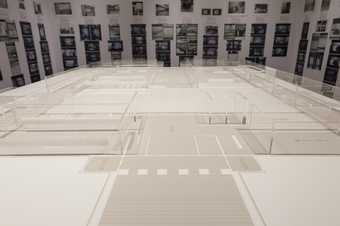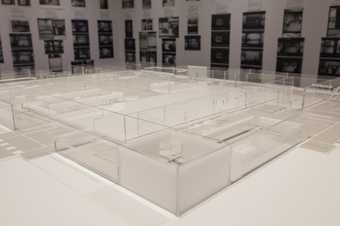This panel, comprising art critic Toshiaki Minemura and artist Susumu Koshimizu, and chaired by professor Yohko Watanabe, presented three perspectives on Tokyo Biennale 1970, assessing the impact and significance of this iconic exhibition that took place at the Tokyo Metropolitan Art Gallery on 10–30 May 1970.
Yokho Watanabe’s paper introduced the curatorial structure of the 1970 Tokyo Biennale, situating the event within the wider context of international exhibitions held between 1969 and 1970. Watanabe observed that following the controversy surrounding the 1968 Venice Biennale, when a group of Italian students from the Accademia Art School had protested the exhibition’s opening, the organising committee for the Biennale had felt compelled to review the format of the exhibition. Unlike the previous Tokyo Biennales, which had grouped artists into pavilions according to nationality, the curator of the 1970 Biennale, Yusuke Nakahara, selected artists according to his chosen theme Between Man and Matter. Crucially, thirteen out of the forty artists whom Nakahara selected were Japanese. To make his selection, Nakahara researched and visited numerous exhibitions in Europe and America, developing an interest in a work of art’s potential to reveal contingent relationships between the artist, his material and the public in ways that would point to the ‘real world’. Reflecting a shift towards installation art, Nakahara encouraged participating artists to engage directly with the site, enacting temporal works and gestures conceived and constructed in-situ.
Watanabe then contrasted Nakahara’s curatorial approach with that of Harald Szeeman. Szeeman exercised total curatorial control over the display of the 1969 exhibition When Attitudes Become Form at Kunstalle Bern, presenting multiple artworks by different artists within the same space. By contrast, Nakahara refrained from imposing his own stylistic preferences, allowing the Biennale to be shaped by the invited artists. Referring to floor plans which Watanabe had reconstructed for the 2016 Keio University Art Center exhibition Introduction to Archives XIII: Tokyo Biennale ’70, Revisited (see images above), she suggested that Nakahara’s installation of the exhibition, by providing an individual room for each artist, further exemplified his commitment to represent artists without drawing generational, national or stylistic distinctions.
In the final segment of her paper, Watanabe argued that Nakahara created an egalitarian exhibition model by selecting Japanese artists based on their artistic potential rather than established reputation. However, Watanabe then reflected on the absence of women artists from the exhibition, noting that while Nakahara had later spoken about his intentions to invite Eva Hesse, there was no conscious effort on his part to address the representation of women artists. Marisa Merz and Joan Jonas attended as guests rather than participants, while Monika Baumgartl played a role in Klaus Rinke’s performance Masculine-Feminine but was not credited. Watanabe concluded that despite this shortcoming, Nakahara set a precedent for future Biennales in Japan by realising a Biennale that focused squarely on the conceptual parameters of art and art-making. It is for this reason, Watanabe argued, that the Biennale created such a significant ‘contact point’ for Japanese artists, critics and curators.
Toshiaki Minemura’s paper A Perspective Review of the Tokyo Biennale 1970 through the Eyes of Criticism offered a critique of the event from his vantage point as someone who was involved in the Biennale. In addition to assisting Nakahara with the organisation of the exhibition, Minemura played a pivotal role in its formation, suggesting three new guidelines for the Biennale, all of which the sponsor Mainichi Newspaper took on board: the Biennale must be led by a commissioner; artists should represent themselves and not countries; and there should be no juried prize.
Minemura’s paper also outlined the wider art historical context within which the Biennale took place. For Minemura, the proliferation of new art practices and movements in Japan during the 1960s and early 1970s corresponded with the unprecedented emergence of avant-garde forms worldwide. Between Man and Matter, Minemura argued, presented a unique opportunity to demonstrate that the ‘avant-garde’ in Japan comprised of a plurality of artistic approaches, ranging from Socialist reportage painting to entirely new strategies of art-making best exemplified by the work of collectives such as Zero Jigen, Gutai, Mono-ha and High Red Centre. Therefore, Tokyo Biennale 1970 represented a pivotal moment when these competing new forms could coalesce on a single platform. Minemura concluded his paper by suggesting that while Nakahara had succeeded in representing a plurality of art forms, he had neglected to address the mediating role of language in enabling a dialogue between artist, material and the public implied in the title Between Man and Matter.
Speaking from his experience as one of the youngest participating artists at the Biennale, in addition to providing his own analysis of the exhibition Susumu Koshimizu’s paper also provides an account of his early artistic formation as a key member of the art movement Mono-ha. Increasingly critical of mass culture and standardized society, Koshimizu felt compelled to re-assess the role of art in postwar Japan. A seminal moment of realization came when he was helping fellow artist Nobuo Sekine to dig a hole in the ground for the work Phase—Mother Earth (1968). It dawned on him then that the strategy of exploring the intersection between the natural and the man-made by directly engaging with the elements of a surrounding space engendered the possibility of new meanings and encounters. In this case, the physical intervention of digging a hole in the space drew attention to tensions between body and matter, mind and material, therefore revealing interdependent relationships between time and site as well as consciousness and existence.
Turning to the Biennale, Koshimizu noted critic Yoshiaki Tono’s support for Mono-ha and reflected on the significance of Nakahara’s inclusion of artists from outside Tokyo, as well as less internationally known and younger artists who were given the opportunity to exhibit alongside established names from the USA and Europe. Revisiting examples of works created by Carl Andre, Sol Lewitt, Jannis Kounellis and Christo in Japan, Koshimizu assessed these artists’ responses to the exhibition site, also recounting their interactions with Japanese artists. He concluded his presentation on a celebratory note concerning the power of nature as a creative force and applauded the artists of Tokyo Biennale 1970 for having richly demonstrated the spirit of adaptation.
By presenting a multi-vocal re-assessment of Tokyo Biennale 1970, this panel shed light on many lesser known details behind the organisational structure of the event, its curatorial and critical context, and its participants’ responses. As a culmination of Yohko Watanabe’s research, this project to recover a seminal moment in Japan and map its location within a wider history of practices of the global artistic avant-garde, has provided a productive point of departure for locating other contact points between the Japanese art world and art worlds elsewhere which today define the ‘contemporary’.



